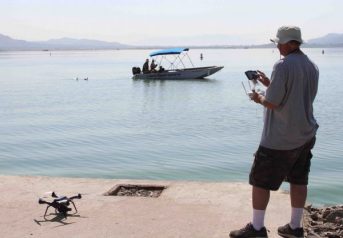Effort launched to adapt UAS to monitor HABs in lakes

SCCWRP and its partners have launched an effort to adapt commercially available unmanned aerial systems (UAS) for routine monitoring of lakes susceptible to ecologically disruptive cyanobacteria blooms.
UAS technology – commonly known as drones – offers the potential to conduct more comprehensive, frequent HABs monitoring at a lower cost than is feasible with traditional boat-based field sampling.
During initial test flights in August and September, digital cameras and multispectral imaging sensors mounted to UAS were flown over Lake Elsinore in Riverside County to map chlorophyll-a concentrations across the lake’s surface.
Researchers then analyzed patterns in the chlorophyll-a concentrations to look for evidence of harmful algal blooms (HABs).
The goal is to develop standardized, reliable methods for conducting UAS-based surveys and analyzing the chlorophyll-a maps, including being able to differentiate cyanobacteria from other phytoplankton groups.
HABs events, which have led to multiple lake closures across California in recent years, trigger production of cyanobacteria toxins that can impair water quality and threaten the health of humans, wildlife and domestic pets.
During the initial test flights, researchers also collected water samples from Lake Elsinore in boats to evaluate the accuracy of the chlorophyll-a analyses. Additionally, a team from the University of Southern California deployed an autonomous underwater vehicle (AUV) to provide information on conditions beneath the lake’s surface.
SCCWRP and its partners are evaluating these data sets to determine how well UAS image-based mapping data for HABs corresponds to data from water samples collected at and below the surface.
More news related to: Eutrophication